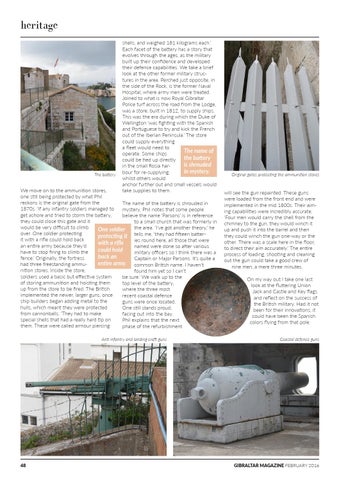heritage
The battery
shells, and weighed 181 kilograms each.’ Each facet of the battery has a story that evolves through the ages, as the military built up their confidence and developed their defence capabilities. We take a brief look at the other former military structures in the area. Perched just opposite, in the side of the Rock, is the former Naval Hospital, where army men were treated. Joined to what is now Royal Gibraltar Police turf across the road from the Lodge, was a store, built in 1812, to supply ships. This was the era during which the Duke of Wellington ‘was fighting with the Spanish and Portuguese to try and kick the French out of the Iberian Peninsula.’ The store could supply everything a fleet would need to The name of operate. Some ships the battery could be tied up directly is shrouded in the small Rosia harin mystery. bour for re-supplying, whilst others would anchor further out and small vessels would take supplies to them.
We move on to the ammunition stores, one still being protected by what Phil reckons is the original gate from the The name of the battery is shrouded in 1870s. ‘If any infantry soldiers managed to mystery. Phil notes that some people get ashore and tried to storm the battery, believe the name ‘Parsons’ is in reference they could close this gate and it to a small church that was formerly in would be very difficult to climb the area. ‘I’ve got another theory,’ he One soldier over. One soldier protecting protecting it tells me, ‘they had fifteen batterit with a rifle could hold back ies round here, all those that were with a rifle an entire army because they’d named were done so after various could hold have to stop firing to climb the military officers so I think there was a back an fence.’ Originally, the fortress Captain or Major Parsons. It’s quite a entire army. common British name. I haven’t had three freestanding ammunition stores. Inside the store, found him yet so I can’t soldiers used a basic but effective system be sure.’ We walk up to the of storing ammunition and hoisting them top level of the battery, up from the store to be fired. The British where the three most implemented the newer, larger guns, once recent coastal defence ship builders began adding metal to the guns were once located. hulls, which meant they were protected One still stands proud, from cannonballs. ‘They had to make facing out into the bay. special shells that had a really hard tip on Phil explains that the next them. These were called armour piercing phase of the refurbishment Anti infantry and landing craft guns
48
Original gates protecting the ammunition stores
will see the gun repainted. These guns were loaded from the front end and were implemented in the mid 1800s. Their aiming capabilities were incredibly accurate. ‘Four men would carry the shell from the chimney to the gun, they would winch it up and push it into the barrel and then they could winch the gun one-way or the other. There was a scale here in the floor, to direct their aim accurately.’ The entire process of loading, shooting and cleaning out the gun could take a good crew of nine men, a mere three minutes. On my way out I take one last look at the fluttering Union Jack and Castle and Key flags and reflect on the success of the British military. Had it not been for their innovations, it could have been the Spanish colors flying from that pole. Coastal defence guns
GIBRALTAR MAGAZINE FEBRUARY 2016
